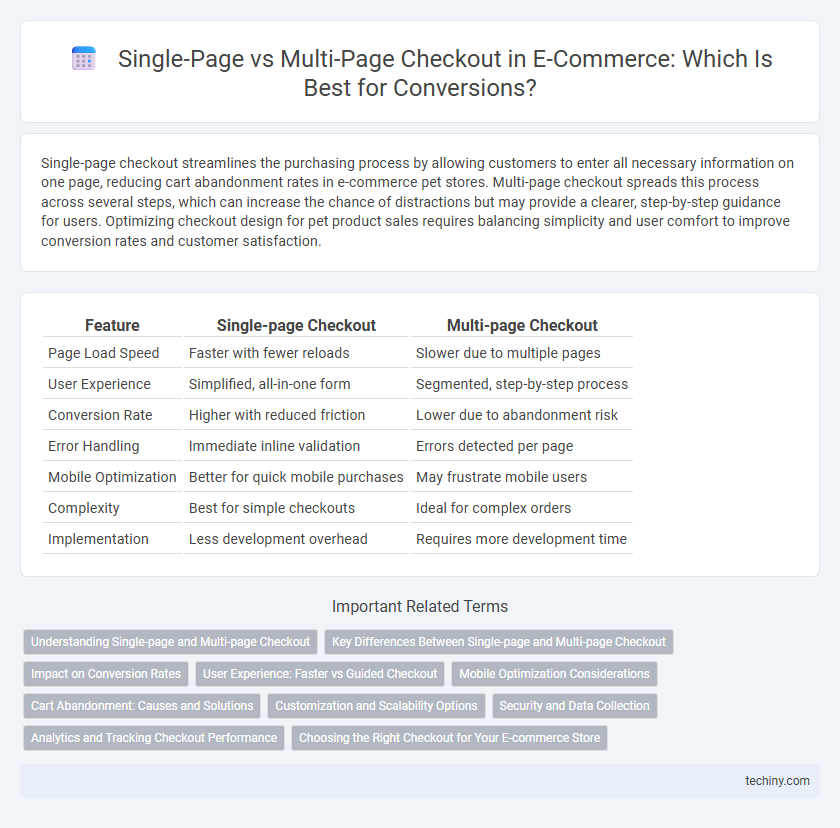Single-page checkout streamlines the purchasing process by allowing customers to enter all necessary information on one page, reducing cart abandonment rates in e-commerce pet stores. Multi-page checkout spreads this process across several steps, which can increase the chance of distractions but may provide a clearer, step-by-step guidance for users. Optimizing checkout design for pet product sales requires balancing simplicity and user comfort to improve conversion rates and customer satisfaction.
Table of Comparison
| Feature | Single-page Checkout | Multi-page Checkout |
|---|---|---|
| Page Load Speed | Faster with fewer reloads | Slower due to multiple pages |
| User Experience | Simplified, all-in-one form | Segmented, step-by-step process |
| Conversion Rate | Higher with reduced friction | Lower due to abandonment risk |
| Error Handling | Immediate inline validation | Errors detected per page |
| Mobile Optimization | Better for quick mobile purchases | May frustrate mobile users |
| Complexity | Best for simple checkouts | Ideal for complex orders |
| Implementation | Less development overhead | Requires more development time |
Understanding Single-page and Multi-page Checkout
Single-page checkout consolidates all purchase steps--such as billing, shipping, and payment--onto a single webpage, reducing friction and speeding up the transaction process. Multi-page checkout divides these steps across several pages, which can help guide users through each part but may increase cart abandonment due to longer completion time. E-commerce platforms must evaluate user behavior and conversion metrics to determine which checkout design maximizes sales and customer satisfaction.
Key Differences Between Single-page and Multi-page Checkout
Single-page checkout consolidates all order and payment information on a single screen, reducing load times and minimizing cart abandonment rates through a streamlined user experience. Multi-page checkout divides the process into several steps, which can provide clarity and guidance but often increases the time to complete purchases and may frustrate users seeking quick transactions. Studies indicate single-page checkouts typically improve conversion rates by simplifying navigation, while multi-page checkouts may benefit complex purchases requiring detailed input.
Impact on Conversion Rates
Single-page checkout streamlined the purchasing process, significantly reducing cart abandonment by minimizing load times and simplifying navigation. Multi-page checkout, while potentially overwhelming users, allows detailed data collection and step-by-step progress, which can boost trust for complex transactions. Studies show that single-page checkouts can increase conversion rates by up to 21%, but optimal results depend on product type and user demographics.
User Experience: Faster vs Guided Checkout
Single-page checkout significantly enhances user experience by offering a faster, more streamlined process that reduces cart abandonment rates. Multi-page checkout, while slower, provides a guided approach that helps users complete complex transactions with ease by breaking steps into manageable sections. Choosing between the two depends on balancing speed and clarity to optimize conversion rates in e-commerce platforms.
Mobile Optimization Considerations
Single-page checkout enhances mobile user experience by minimizing page loads, reducing wait times, and allowing seamless form completion within a compact interface optimized for touchscreens. Multi-page checkout can lead to higher dropout rates on mobile due to repeated navigation and slower page transitions, but it benefits from dividing information into manageable steps that reduce cognitive load. Optimizing mobile e-commerce checkouts requires balancing simplicity and clarity, leveraging responsive design principles, and testing user flow to ensure minimal friction and faster conversions.
Cart Abandonment: Causes and Solutions
Single-page checkout reduces cart abandonment by streamlining the purchase process, allowing customers to review and complete orders without navigating away from the cart. Multi-page checkout can increase abandonment rates due to longer, more fragmented workflows that frustrate users and heighten drop-off risk. Implementing user-friendly designs, progress indicators, and minimizing form fields in both methods helps optimize the checkout experience and reduce abandonment.
Customization and Scalability Options
Single-page checkout offers streamlined customization with dynamic fields and real-time validation, enhancing user experience and reducing cart abandonment. Multi-page checkout provides greater scalability, allowing easy integration of complex features like multi-shipping options, upselling, and advanced payment methods. E-commerce platforms benefit from multi-page designs when expanding product lines or targeting diverse customer segments requiring tailored workflows.
Security and Data Collection
Single-page checkout streamlines the payment process by consolidating all form fields on one page, reducing abandonment rates while maintaining secure data encryption protocols such as SSL/TLS. Multi-page checkout enhances data security by compartmentalizing information entry, which allows for more detailed fraud detection and step-by-step validation, but may increase cart abandonment due to longer completion times. Both methods integrate advanced compliance standards like PCI DSS to protect sensitive payment data and optimize user trust in e-commerce transactions.
Analytics and Tracking Checkout Performance
Single-page checkout consolidates all purchase steps on one page, enhancing user experience and enabling streamlined analytics by reducing tracking complexity and session drop-offs. Multi-page checkout allows granular tracking of customer behavior at each step, providing detailed insights into conversion funnels and points of friction. Analyzing metrics like abandonment rates, time per step, and drop-off patterns in both models helps optimize checkout performance and increase completion rates.
Choosing the Right Checkout for Your E-commerce Store
Single-page checkout streamlines the purchasing process by consolidating all payment and shipping fields on one page, reducing cart abandonment rates by enhancing user convenience. Multi-page checkout segments the process into distinct steps, which can provide clarity and guide the customer through complex orders or upsell opportunities. Selecting the right checkout format depends on your store's product complexity, target audience, and conversion optimization goals, with A/B testing often revealing which approach maximizes completed transactions.
Single-page Checkout vs Multi-page Checkout Infographic

 techiny.com
techiny.com